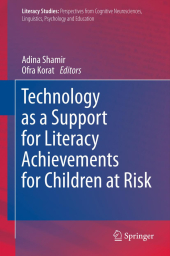 Neuerscheinungen 2014Stand: 2020-02-01 |
Schnellsuche
ISBN/Stichwort/Autor
|
Herderstraße 10
10625 Berlin
Tel.: 030 315 714 16
Fax 030 315 714 14
info@buchspektrum.de |

Ofra Korat, Adina Shamir
(Beteiligte)
Technology as a Support for Literacy Achievements for Children at Risk
Herausgegeben von Shamir, Adina; Korat, Ofra
2013. 2014. vi, 238 S. 16 SW-Abb.,. 235 mm
Verlag/Jahr: SPRINGER NETHERLANDS; SPRINGER 2014
ISBN: 9400797621 (9400797621)
Neue ISBN: 978-9400797628 (9789400797628)
Preis und Lieferzeit: Bitte klicken
Arguing that literacy is crucial for integration into modern society, this book focuses on the uses of technology in supporting and advancing literacy in at-risk groups such as those with learning disabilities, low socioeconomic status and minority ethnicity.
Presenting cutting-edge studies from various countries into the theoretical and practical issues surrounding the literacy acquisition of at-risk children, this volume focuses specifically on the utility of technology in supporting and advancing literacy among the relevant populations. These include a range of at-risk groups such as those with learning disabilities, low socioeconomic status, and minority ethnicity.
Arguing that literacy is a key requirement for integration into any modern society, the book outlines new ways in which educators and researchers can overcome the difficulties faced by children in these at-risk groups. It also reflects the rapid development of technology in this field, which in turn necessitates the accumulation of fresh research evidence.
Introduction: Technology as a Support for Literacy Achievements for Children at Risk by Adina Shamir and Ofra Korat .- Early Childhood 1. Effects of an Adaptive Game on Early Literacy Skills in At Risk Populations by Adriana G. Bus and Cornelia A.T. Kegel .- 2. Giving All Children a Good Start: The Effects of an Embedded Multimedia Intervention for Narrowing the Vocabulary Gap Before Kindergarten by Susan B. Neuman .- 3. Video Storybooks - A Way to Empower Children at Risk by Maria T. de Jong and Marian J.A. J. Verhallen .- 4. Print to Pixel: Foundations of an E-Book Instructional Model in Early Literacy by Kathleen Roskos and Karen Burstein .- 5. What Can Better Support Low SES Children´s Emergent Reading? Reading E-Books and Printed Books with and without Adult Mediation by Ora-Segal Drori, Ofra Korat and Pnina S. Klein .- 6.The Effects of Multimedia on Early Literacy Development of Children at Risk: A Meta-Analysis by Victor van Daal and Jenny Miglis Sandvik .- School Children 7. Teachers´ Use of Assessment to Instruction (A2i) Software and Third Graders´ Reading Comprehension Gains by C.M. Connor, B. Fishman, E. Crowe, P. Underwood, C. Schatschneider and F. Morrison .- 8. An Online Learning Community as Support for A1- Risk Students´ Literacy Growth-Findings, Implications, and Challenges by William H. Teale, Katie Lyons, Linda Gambrell, Nina Zolt, Rebecca Olien and Donald J. Leu .- 9. Stimulating Self-regulated Learning in Hypermedia to Support Mathematical Literacy of Lower-achieving Students by Bracha Kramarski .- Special Educational Needs 10. Promoting Emergent Literacy of Children at Risk for Learning Disabilities: Do E-books Make a Difference? By Adina Shamir, Ofra Korat and Renat Fellah .- 11. Early Literacy Interventions using ICT in Children with SLI by Eliane Segers and Anna M. T. Bosman .- 12. Making a Difference: Using Laptops as a Support for Spelling Improvement among Students with Learning Disability by Sigal Eden, Adina Shamir and Maayan Fershtman .- 13. Nonliteral Comprehension Deficits in Children with Learning Disabilities: Implications of Brain Imaging Technology by Nira Mashal .- 14. Use of Technology for Literacy Acquisition among Children with Communication Difficulties by Orit E. Hetzroni


